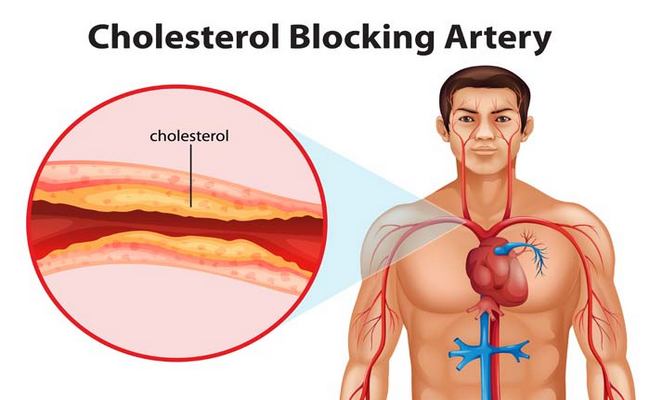Angina Definition or Angina Pectoris:
Angina disease is chest pain or discomfort caused by inadequate oxygen supply resulting in low blood flow to the heart muscle.

Types of Angina Disease or Classification of Angina:
There are two types of Angina. Those are discussed below:
1. Stable Angina Disease or Angina Pectoris:
The sensation of chest pain, the pressure of squeezing due to obstruction or spasm of the coronary arteries. It occurs when the heart muscle does not get as much blood as it needs resulting in ischemia. The pain usually radiates to the neck, jaw, shoulder, or arm and is relieved with rest, nitroglycerin, or both.
2. Unstable Angina Disease:
It refers to unexpected chest pain due to coronary arteries narrowed by fatty build-ups. Atherosclerosis can rupture blood vessels resulting in blood clotting which blocks the blood flow to the heart muscle. It does not relieve with rest or medicine and may get worse over time.
Sign and Symptoms of Angina Disease or Angina Symptoms:
Various sign and symptoms are mentioned in the following:
Sl. No. | Stable Angina | Unstable Angina |
1 | Occurs when the heart works hard during physical exercise. | Occurs neither at rest while sleeping nor with little physical exertion. |
2 | Does not come as a surprise. | Come as surprise and sudden. |
3 | Usually, last a short time(5 minutes or less) | Is more severe and lasts longer than stable Angina (as long as 30 minutes). |
4 | Usually relieved with rest of medicine. | Not relieved by rest or medicine. |
5 | May feel like gas or indigestion. | May get worse over time. |
6 | Usually radiates to arms, neck, jaw, and shoulder. | Might signal a heart attack. |
Causes of Angina Disease:
There are different causes of both types of Angina. Those are in the following:
For Stable Angina:
The main causes for this are-
- Emotional stress,
- Physical exertion,
- Heavy meals,
- Smoking,
- Exposure to extreme hot or cold weather.
For Unstable Angina:
The main cause s for unstable angina are-
- Blood clots,
- Atherosclerosis
Major Risk Factors of Angina Disease:
Those are in the following-
- Age (≥45 years for men, ≥55 years for women),
- Smoking,
- Dyslipidemia,
- Hypertension,
- Obesity,
- Physical inactivity,
- Prolonged psychological stress,
- Family history of CVD,
- Hypovolemia,
- Hypothermia,
- Hypervolemia
- Valvular heart disease,
- Tachyarrhythmia or Brady arrhythmia.
Diagnostic Test for Angina Disease:
The main diagnostic tests for this area in the following:
- ECG,
- Chest X-Ray,
- Stress Testing,
- Coronary Angiography,
- CT Angiography,
- Blood tests (High level of cholesterol, fats, sugar, and proteins in the blood may show risk factors for CHD),
- Nuclear stress test.
Treatment for Angina Disease or Angina Disease Treatment:
By following the way the treatment should be done.
1. Lifestyle Changes,
2. Medicine:
- Nitroglycerin,
- Morphine,
- Oxygen,
- Aspirin,
- Beta-blockers,
- Calcium channel blockers,
- ACE inhibitors,
These medicines can help to-
- Lower blood pressure and cholesterol levels,
- Slow the heart rate,
- Relax blood vessels,
- Reduction strain on the heart,
- Prevent blood clots.
3. Medical procedures:
- Coronary Artery Bypass Grafting (CABG),
- Percutaneous coronary intervention.
Nursing Intervention for Angina Disease:
Nursing interventions for angina have pointed out in the below-
- Take immediate action if a patient complains of chest pain.
- Direct the pt to stop all activities.
- Keep the pt semi-fowler’s position and ensure rest.
- Administer oxygen and keep saturation >95% as a result oxygen will reach the heart muscle.
- Assess and document continuous ECG rhythm.
- Check vital signs and mental status with complaints of chest pain and compare with baseline.
- Monitor pain characteristics: location and intensity relief symptoms.
- Administer nitroglycerin sublingually and check pt response.
- After administering nitroglycerin, check vital signs in every 15 minutes and maintain systolic blood pressure >90mmhg.
- Administer medications as order.
- Administer Inj morphine I/V to relieve pain and decrease preload.
- Obtain a 12 lead ECG.
- Instruct patient to avoid activities.
- Discourage alcoholism, beverage, and smoking.
- Provide essential information about the illness that the patient can recognize problems and can seek medical support.
- Encourage verbalization of fear and anxiety and provide feedback.
- Prepare the patient for percutaneous coronary intervention.
- Provide a calm and quiet environment.
More questions related to this topic:
- What is Angina of the Heart?
- What Does Angina Feel Like?
- What is Chronic Stable Angina?
- Heart Disease and Angina (Chest Pain).
- Stable Angina: Causes, Symptoms, & Treatment.
- Angina | Causes | Prevention | Treatments.
- Angina: Get Facts on Pain and Treatment.
- Definition of Angina Disease or Angina Diabetes or Hypertension Disease.
- What is Angina (Chest Pain)?
- What are the Symptoms of Angina Pectoris?

Maria Khatun Mona is a Founder and Editor of Nursing Exercise Blog. She is a Nursing and Midwifery Expert. Currently she is working as a Registered Nurse at Evercare Hospital, Dhaka, Bangladesh. She has great passion in writing different articles on Nursing and Midwifery. Mail her at “maria.mona023@gmail.com”
